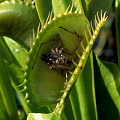Q: How do I get rid of dead bug skeletons in my Venus flytrap?

Crunchy!
A: First off, before my entomologist buddies get annoyed,
I will remind you that insects and their kind
do not have "skeletons" in the sense of endoskeletons like yours and mine, they have exoskeletons.
That said, we proceed to the meat of the matter. Suppose you fed your Venus flytrap a
nice tasty spider. Several days later, you notice that the plant has finished
its meal, splayed its leaves, and has opened shop for business again. It beckons
to you, "Food! More food!" But what about that nasty dead bug still stuck
in the plant's trap--the remains of its previous meal? If you try to take it
out, the leaves will snap shut. What should you do?
In the best possible scenario, you would remove the dead bug on the same day
the leaf opened. The still-moist bug usually comes out quite easily, and the
plant may not close (the best time to do this is when the leaf has not
quite opened to its cocked and ready stage). If you missed this brief
opportunity, the dead bug will probably dry out and
stick to the inner leaf surface. In this case, you can use a
spray bottle to moisten the prey. A squirt gun or water pistol
works well, too. (I encourage you to adopt a strange accent and pretend
you are a big-game hunter in search of quarry. Dressing appropriately in a
khaki outfit--oh, and a pith helmet--would complete the effect.)
Once the dead bug is moistened, pliable,
and no longer adherent to the leaf, you can use
tweezers to extract the hydrated carcass. Despite your best efforts, it is
still quite possible the trap will spring. Alas.
In the wild, the dews, rains, and winds conspire to remove dead bugs from traps. I rarely
see a wild Dionaea
with the remains of a dead bug in its traps.
Really, though, I do not think it is necessary to remove the dead "husks"
(as the great horticulturist Adrian Slack called these things). They do not
cause the plant any great trouble, and if you have ever seen a big Venus flytrap
with every trap proudly holding forth a dead earwig or spider, you would no doubt
agree the effect is riveting!
Page citations: Slack, A. 1979; personal observation.